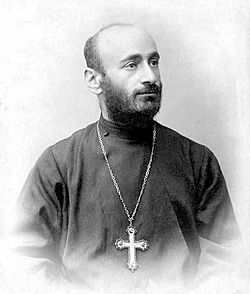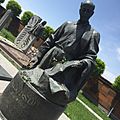Komitas Vardapet facts for kids
Quick facts for kids
Komitas
Vardapet
|
|
|---|---|

Komitas in 1901 or 1902
|
|
| Born |
Soghomon Soghomonian
8 October [O.S. 26 September] 1869 |
| Died | 22 October 1935 (aged 66) |
| Resting place | Komitas Pantheon |
| Nationality | Armenian |
| Education | Gevorgian Seminary Frederick William University |
| Occupation | Musicologist, composer, choirmaster |
| Years active | 1891–1915 |
| Signature | |
 |
|
Komitas (born Soghomon Soghomonian) was a famous Armenian priest, musicologist, and composer. He lived from 1869 to 1935. Many people consider him the founder of Armenian national music. He was also one of the first people to study ethnomusicology. This is the study of music from different cultures.
Komitas became an orphan when he was very young. He was taken to Etchmiadzin Cathedral, a religious center in Armenia. There, he studied at the Gevorgian Seminary. In 1895, he became a vardapet, which is a type of priest. After that, he went to Berlin to study music at the Frederick William University.
Komitas's Musical Journey
Komitas spent a lot of time collecting and writing down Armenian folk music. He gathered over 3,000 pieces. Sadly, more than half of these songs were lost over time. Today, only about 1,200 of them remain.
He was also interested in music from other cultures. In 1904, he published the very first collection of Kurdish folk songs. His choir performed Armenian music in many cities across Europe. People loved his performances. Many praised his work.
In 1910, Komitas moved to Constantinople (now Istanbul). He wanted to share Armenian folk music with even more people. Armenian communities welcomed him warmly. A writer named Arshag Chobanian even called him the "savior of Armenian music."
Later Life and Legacy
In April 1915, during the Armenian Genocide, Komitas was arrested. He was sent to a prison camp along with many other Armenian thinkers. He was released soon after, but the experience deeply affected him. He became very unwell and struggled with his mental health. The difficult situation in Constantinople made his condition worse.
In 1916, he was taken to a hospital in Constantinople. Later, in 1919, he moved to Paris, France. He passed away in a special clinic in Villejuif in 1935. The next year, his ashes were brought back to Yerevan, Armenia. He was buried in a special place called the Pantheon, which was named after him.
Komitas is seen as a hero and a symbol of the Armenian Genocide. His life and music continue to inspire many people. The Yerevan State Musical Conservatory is named after him. There is also a famous string quartet that carries his name.
Images for kids
-
The Frederick William University around 1900.
-
The statue of Komitas in Yerevan.
See also
 In Spanish: Komitas Vardapet para niños
In Spanish: Komitas Vardapet para niños








